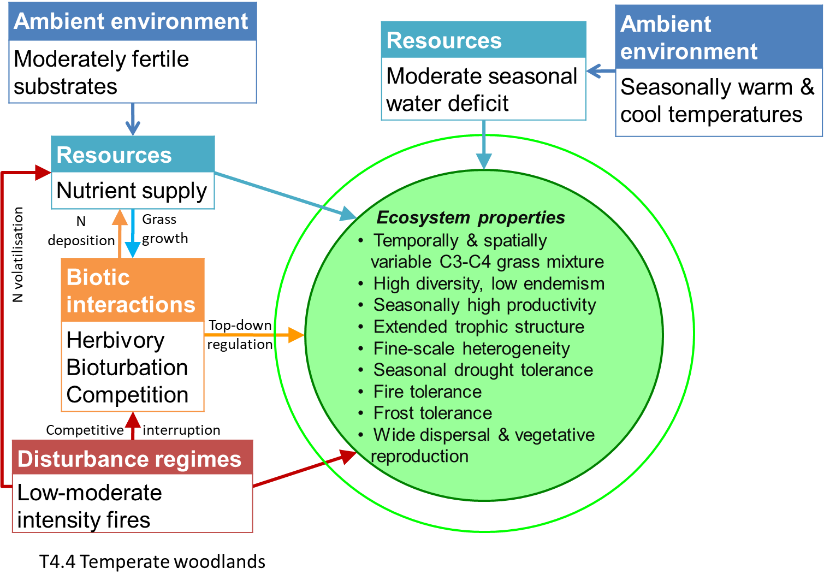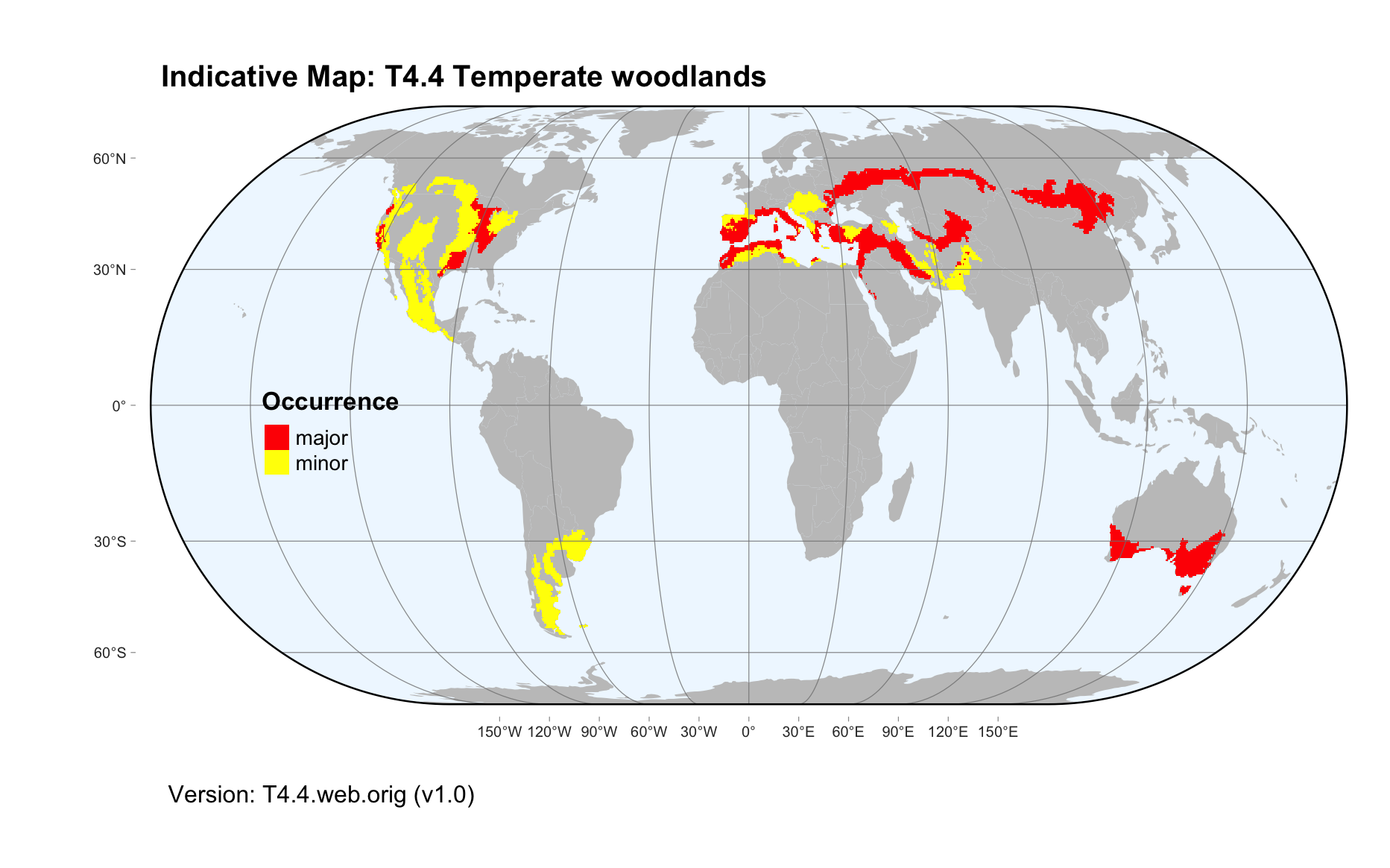Global ecosystem typology
Alternative site for the Global ecosystem typology with additional information for ecosystem profiles and indicative maps.
This site is maintained by jrfep
T4.4 Temperate woodlands
Biome: T4. Savannas and grasslands biome
Contributors:
(texts)
Temperate woodlands are structurally simple, with widely-spaced trees and a ground layer of grasses with scattered shrubs. They are globally distributed in temperate climates with warm-season droughts. Tree foliage is typically evergreen, but may be deciduous in cold dry climates. During warm summers, productive grasses on fertile soils sustain a complex foodweb of insects, reptiles, birds and mammals. The ground flora varies with rainfall and tree cover, which creates diverse microhabitats beneath. Large herbivores and their predators are important to maintaining woodland composition, with burrowing mammals influencing soil and nutrient cycling. Fires occur periodically, but have less influence than in pyric savannas (T4.2) or forests (T2.6).
Key Features
Open-canopy woodlands, trees microphyll and evergreen, with herbaceous understory including C3 and/or C4 grasses.
Overview of distribution
Temperate regions worldwide with summer water deficit, some with winter precipitation.
Profile versions
- v1.0 (2020-01-20): DA Keith; D Faber-Langendoen; J Franklin
- v2.0 (2020-09-04): DA Keith; D Faber-Langendoen; J Franklin
- v2.01 ():
- v2.1 (2022-04-06): DA Keith; D Faber-Langendoen; J Franklin Full profile available at official site
Main references
Selected references for this functional group:
Gibson GJ (2009) Grasses and grassland ecology Oxford University Press, Oxford
Prober SM, Gosper CR, Gilfedder L, Harwood TD, Thiele KR, Williams KJ, Yates CJ (2017) Temperate eucalypt woodlands Australian vegetation (Ed. DA Keith), pp 410-437. Cambridge University Press, Cambridge. ISBN 978-1-107-11843-0
Davis FW, Baldocchi DD, Tyler CM (2019) Oak woodlands Ecosystems of California (Eds. HA Mooney, E Zavaleta). Chapter 25 pp 509-534. University of California Press, Berkeley DOI:10.1525/9780520962170-029
Diagrammatic assembly model

Maps
Maps are indicative of global distribution patterns are not intended to represent fine-scale patterns. The maps show areas of the world containing major (coloured red) or minor occurrences (coloured yellow) of each ecosystem functional group. See general notes on maps.
There are 2 alternative versions of the indicative map for this functional group, please compare description and sources below.
T4.4.IM.orig_v1.0
Datasets
- Resolve-Ecoregions-2017
Map references
Dinerstein E, Olson D, Joshi A, Vynne C, Burgess ND, Wikramanayake E, Hahn N, Palminteri S, Hedao P, Noss R, Hansen M, Locke H, Ellis EE, Jones B, Barber CV, Hayes R, Kormos C, Martin V, Crist E, Sechrest W, Price L, Baillie JEM, Weeden D, Suckling K, Davis C, Sizer N, Moore R, Thau D, Birch T, Potapov P, Turubanova S, Tyukavina A, de Souza N, Pintea L, Brito JC, Llewellyn Barnekow Lillesø JP, van Breugel P, Graudal L, Voge M, Al-Shammari KF, Saleem M (2017) An Ecoregion-Based Approach to Protecting Half the Terrestrial Realm, BioScience 67: 534–545. DOI:10.1093/biosci/bix014. Data-set available on-line
T4.4.web.orig_v1.0

Datasets
- Resolve-Ecoregions-2017
Map references
Dinerstein E, Olson D, Joshi A, Vynne C, Burgess ND, Wikramanayake E, Hahn N, Palminteri S, Hedao P, Noss R, Hansen M, Locke H, Ellis EE, Jones B, Barber CV, Hayes R, Kormos C, Martin V, Crist E, Sechrest W, Price L, Baillie JEM, Weeden D, Suckling K, Davis C, Sizer N, Moore R, Thau D, Birch T, Potapov P, Turubanova S, Tyukavina A, de Souza N, Pintea L, Brito JC, Llewellyn Barnekow Lillesø JP, van Breugel P, Graudal L, Voge M, Al-Shammari KF, Saleem M (2017) An Ecoregion-Based Approach to Protecting Half the Terrestrial Realm, BioScience 67: 534–545. DOI:10.1093/biosci/bix014. Data-set available on-line
Check: the Glossary / Profile structure / the public document